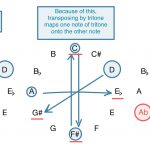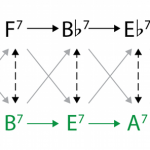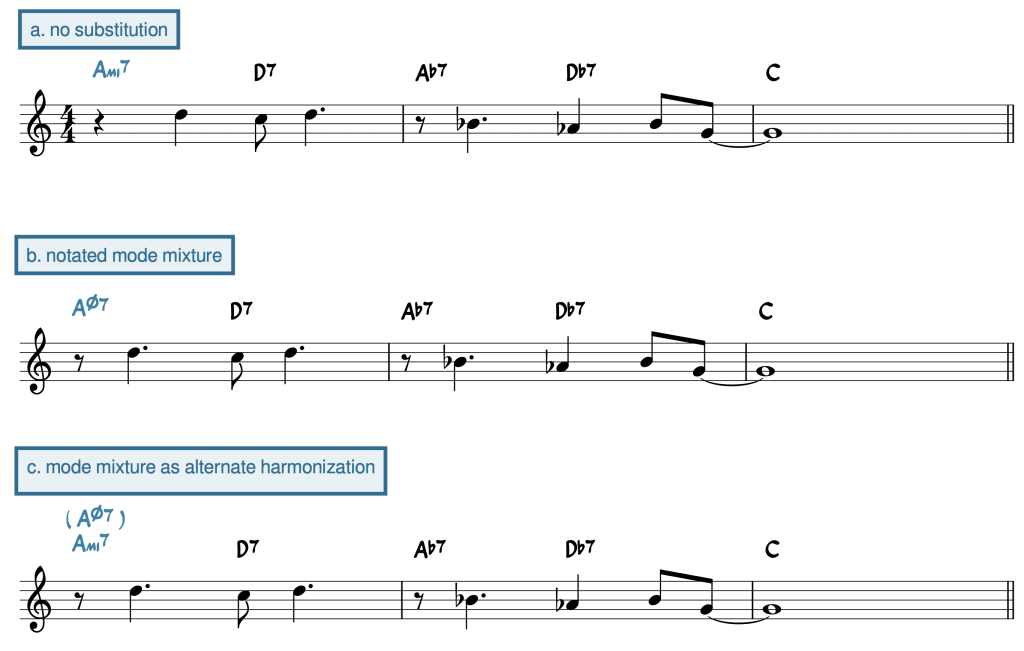VI. Jazz
Substitutions
Megan Lavengood
Key Takeaways
This chapter discusses methods for altering chord progressions through chord substitution.
- A progression that moves by fifth can substitute the first chord with the dominant chord that shares the same root. This makes the first chord an applied chord to the second chord.
- Mode mixture is when a piece in a major key uses chords borrowed from the parallel minor key (or vice versa, though this is less common).
- In jazz, the most common mixture chords are substituting ii∅7 for ii7 and adding ♭9 to a V7 chord.
- The most common mixture chords, including ii∅7 and V7♭9, substitute le for la [latex](\downarrow\hat6[/latex] for [latex]\natural\hat6)[/latex].
- Tritone substitutions replace a dominant chord with another dominant chord a tritone away. The name refers both to the interval between the original and substituted chords and to the fact that the two chords share the same tritone.
Creating new interpretations of old favorite tunes is one of the cornerstones of jazz, and because of this, the concept of chord substitutions is extremely important. Substitutions provide a way for performers and arrangers to put a new spin on more well-trodden harmonic progressions. This chapter uses the turnaround as a basic progression to be altered, but these substitutions can be applied anywhere in a harmonic progression.
Applied Chords as Substitutions
As discussed in the Tonicization chapter, an applied chord can be productively related to the diatonic chord with which it shares a root note.
Because root motion by fifth is extremely common in jazz, there are many opportunities for performers to simply substitute the first chord in a fifth-wise chord progression with the dominant seventh built on the same root. One especially common place where this is implemented is in the turnaround, where, because each chord is related to the next by fifth, a chain of applied V7s is a common variant (Example 1).
Example 1. When a progression has root motion by fifth, the quality of the first chord can be changed to dominant seventh in order to transform it into an applied V7.
Mode Mixture
“All of You” by Cole Porter is a composition that has mode mixture built into it. Listen to this recording by Ella Fitzgerald (transcribed in Example 2), conveniently in C major, and observe how the alternation between A♮ (la, [latex]\hat6[/latex]) and A♭ (le, [latex]\downarrow\hat6[/latex]) catches the ear and imbues a sense of sentimentality in the song. A♭ here can be understood as being borrowed from the parallel minor (C minor), a practice known as mode mixture.
Example 2. “All of You” by Cole Porter uses a minor iv chord (Fmi) and a half-diminished ii chord (D∅7) even though the tonic is major.
Many songs, like “All of You,” have mixture built into their chord structure. But mixture chords can also work as improvised substitutions: a chord within a diatonic chord progression can be substituted with its minor-mode variant to produce a color change that won’t change the overall function of the chord. A mixture substitution works best when the scale degree being inflected is la [latex](\hat6)[/latex], and is therefore being transformed into le [latex](\downarrow\hat6)[/latex]. As an example, consider the turnaround in Example 3: instead of a diatonic version, one may choose to incorporate le [latex](\downarrow\hat6)[/latex] to generate some more colorful harmonies. These particular substitutions—changing a ii7 to a ii∅7, and a G7 to a G7♭9—are particularly common uses of mode mixture in jazz.
Example 3. Mixture chords are most effective when they involve [latex]\mathit{\downarrow\hat6}[/latex]. Mixture and diatonic versions of the same chord have the same function.
Tritone Substitutions

While the above methods of substitution are common in pop and classical styles as well, the tritone substitution (“tritone sub”) is unique to jazz. Tritone subs take the place of V7 chords, either applied or diatonic. The “tritone” part of the name comes from two key roles of tritones in these substitutions:
- The substituted chord is a tritone away from the chord it is replacing.
- The chords are related because they share the same tritone.
This relationship is best explained graphically, as in Example 4: because the tritone evenly divides the twelve-tone collection, transposing by tritone maps the tritone onto itself.
Speaking practically, the bottom line is that any dominant seventh chord can be replaced by the dominant seventh chord a tritone away, and the progression still functions the same way. Not just any V7 chord should be replaced with a tritone substitution, however—this sounds best when the V7 chord is resolving to I rather than moving to any other chord. A tritone substitution in a V7–I progression yields a chromatic bass line that helps connect it to the chords nearby. In fact, the most reliable way to recognize a tritone substitution in a song is by its chromatic resolution downward by a minor second.
Example 5 shows how tritone substitutions are commonly used in the turnaround.
- As discussed above, it’s common to replace the diatonic chords with applied chords that share the same root, yielding a progression consisting entirely of V7 chords—this is shown in the right-hand harmonization on the top row.
- From there, tritone substitutions can be used for any V7 chord.
- Most commonly, every other chord is replaced with a tritone sub, yielding a chromatic bass line and smooth voice leading, as in the bottom row of harmonizations.
Example 5. Because tritone substitutions can replace any applied dominant chord, in progressions moving by fifth like the turnaround, chords may first be (conceptually) substituted with their applied variants, and then tritone substitutions can be used to create a chromatic bass line.

The ii–V–I chapter visualized the ii–V–I schema within a voice-leading space constructed by Michael McClimon (2017). McClimon further visualizes the tritone substitution as a kind of shadowing space behind the typical ii–V space (Example 6). Click here to view his animation of the progression of “Blues for Alice” and its movement through the ii–V space with tritone substitutions. Notice that the tritone-substituted V7 chord is preceded by its ii7 chord, and that both chords are in the green space that McClimon places behind the foreground ii–V space.
Substitutions in a Lead Sheet
As with embellishing chords, substitutions are not always represented the same way in a lead sheet.
- There may not be any substitution notated, and instead the performers are improvising this addition as they play.
- The substitution may be built into the chord progression and thus be notated in the chord symbols.
- The substitution may be indicated as an alternate harmonization and shown in chord symbols with parentheses around the substituted chords.
This is illustrated in Example 7, with different ways of showing a modally mixed ii∅7 chord in “Satin Doll” by Duke Ellington.

- Levine, Mark. 1995. The Jazz Theory Book. Petaluma, CA: Sher Music.
- McClimon, Michael. 2017. “Transformations in Tonal Jazz: ii–V Space.” Music Theory Online 23 (1). http://mtosmt.org/issues/mto.17.23.1/mto.17.23.1.mcclimon.html.
- Bebop composition. Asks students to build on knowledge of swing rhythms, ii–V–I, embellishing chords, and substitutions to create a composition in a bebop style.
- .pdf: Complete instructions + template
- .mscz: Template for lead sheet, template for voicings
- .docx: instructions only
- Bebop composition — audio option. Asks students to build on knowledge of swing rhythms, ii–V–I, embellishing chords, and substitutions to create a composition in a bebop style.
- Substitutions (.pdf, .mscz). Asks students to substitute chords in ii–V–I progressions and in a phrase from Cole Porter’s “Let’s Do It.” Worksheet playlist
Media Attributions
- Clock face visualization © Megan Lavengood is licensed under a CC BY-SA (Attribution ShareAlike) license
- McClimon Figure 10 © Michael McClimon is licensed under a CC BY-SA (Attribution ShareAlike) license
- Parentheses © Megan Lavengood is licensed under a CC BY-NC-SA (Attribution NonCommercial ShareAlike) license
Replacing a standard chord (i.e., within a harmonic schema) with a different chord. The substituted chord is typically identical in harmonic function to the standard chord, and often shares at least two notes with the standard chord.
An augmented fourth or diminished fifth. The name reflects that the two notes of a tritone are three (tri-) whole steps (tones) apart.
The use of a non-tonic chord (usually dominant) at the end of a harmonically closed unit to transition into the beginning of the following on-tonic unit. In jazz, the term "turnaround" often refers to the progression vi–ii–V–I. The exact qualities of these chords are highly variable, and one or more of the chords may be substituted with a different, related chord.
The distance between roots of adjacent chords. For example, "root motion by step" refers to the distance between two chords that are only one step apart, such as I and ii, IV and V, etc. Note that the root is not always in the bass, so this is a separate concept from bass motion.
The intermixing of major and minor versions of 3̂, 6̂, and/or 7̂ within a composition.

